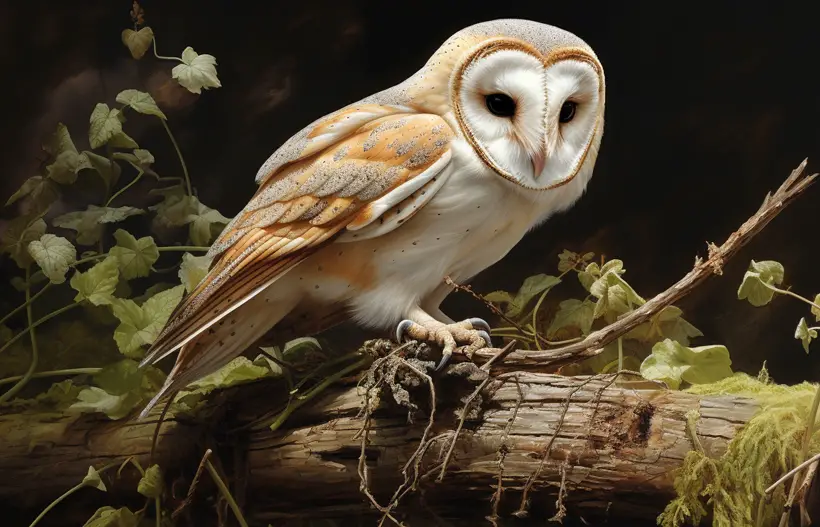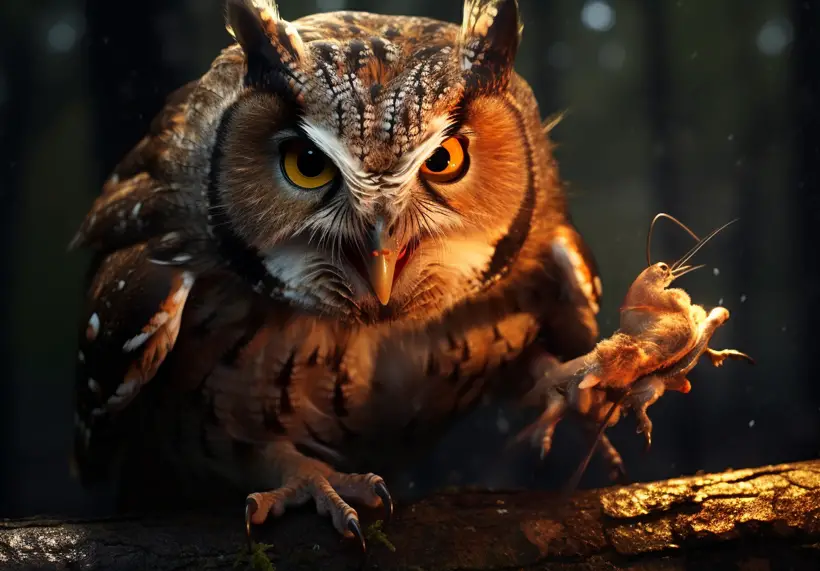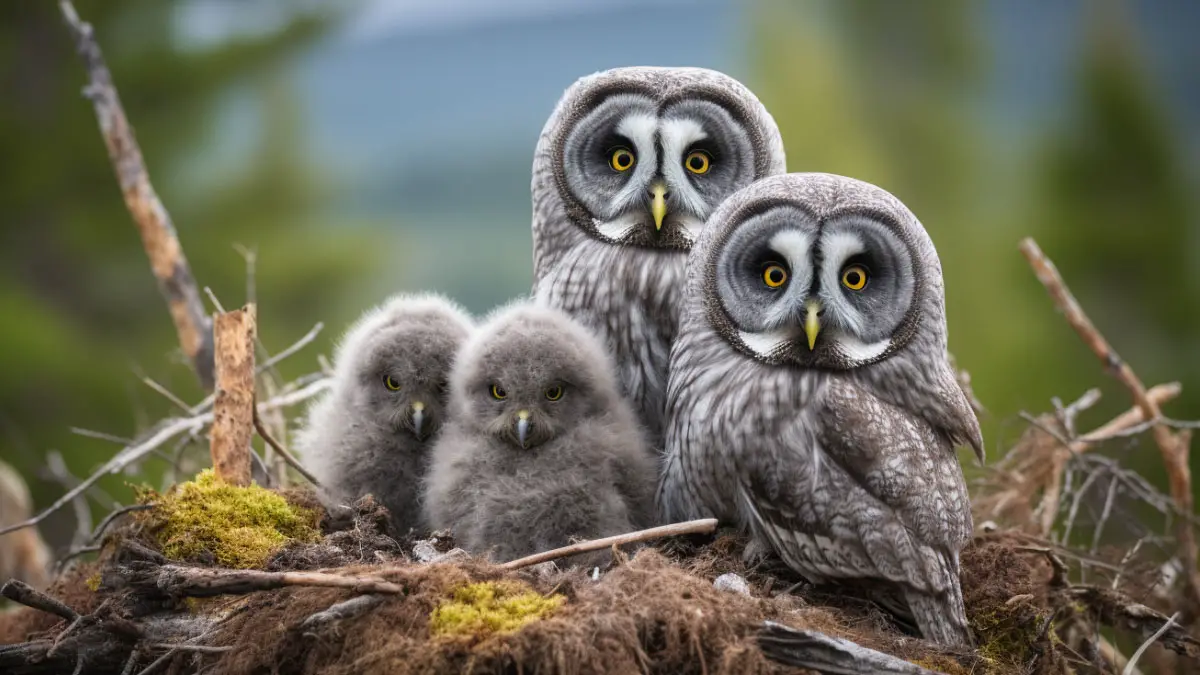Did you know owls can help humans in many ways? One of the ways that owls help us is that they eat harmful rodents and reduce their numbers.
So, you might ask, do owls eat mice? Well, the short answer is YES, owls do eat mice all the time. Mice are one of the most common prey items for a variety of owl species. Various types of rodents, including mice, rats, voles, and squirrels, comprise up to 70% of an owl’s diet.
But, how do they prey and hunt mice? To know that, continue reading and dig out about owls and mice. By the end of this article, you know everything about their relationships.
Do Owls Eat Mice? (In-depth Explanation)
The short answer is yes, owls do eat mice. In fact, mice are one of the most important and preferred prey items for many owl species around the world.
According to a study of owl diets by Marti (2010), rodents (including mice, rats, voles, and squirrels) make up about 70% of the biomass consumed by owls. It’s followed by a diet of birds (15%), insects (8%), and other animals (7%).

However, the proportion of mice in the owl’s diet varies depending on the owl species. For example, barn owls (Tyto alba) are highly specialized in hunting small rodents. Mice can constitute up to 90% of their diet. On the other hand, great horned owls (Bubo virginianus) also rely on mice as a staple food source.
Some owl species also switch their diet according to seasonal changes in prey abundance. For instance, snowy owls (Bubo scandiacus) mainly feed on lemmings in their Arctic breeding grounds. But, they switch to mice and other small mammals when they migrate south in winter.
How Do Owls Hunt For Mice?
Owls have several adaptations that make them efficient hunters of mice and other nocturnal prey.
- First, they have a vision that allows them to see in low-light conditions. Their eyes are large and forward-facing, giving them binocular vision and depth perception. So, they face no problem seeing mice roaming at night.
- Second, they have superb hearing that enables them to locate mice by sound. In their ears, they also have a circular facial disc of stiff feathers.

This acts as a parabolic reflector, funneling sound waves created by mice’s movement to their ears.
- Third, they have a silent flight that allows them to approach mice without being detected. As reported by the non-profit Owl Research Institute, their wings are large and rounded, creating less turbulence than pointed wings. Their feathers are also soft and fringed at the edges, reducing the noise generated by air passing over them.
Different Hunting Strategies:
Owls use different hunting strategies depending on their prey type. Some owls hunt by perching on a branch or a post and scanning the ground for movement.
When they spot a mouse, they swoop down and grab it with their sharp talons. According to National Geographic, this method is common among forest-dwelling owls such as barred owls (Strix varia) and tawny owls (Strix aluco).

Other owls hunt by flying low over open areas such as grasslands or fields and listening for sounds of rodents scurrying below.
When they hear a mouse, they hover briefly and then plunge down with their legs extended. According to a dissertation report by a Ph.D. candidate from Simon Fraser University, this technique is typical of grassland owls such as short-eared owls (Asio flammeus) and barn owls.
Some owls may also hunt by walking or running on the ground and flushing out mice from their hiding places. This behavior is rare among owls but has been observed in burrowing owls (Athene cunicularia) and long-eared owls (Asio otus).
What Nutritional Benefits Do Mice Provide To Owls?
Mice are rich sources of protein, fat, and minerals for owls.
Protein is essential for building and repairing muscles, feathers, skin, and organs. Fat provides energy and insulation, especially in cold weather. Minerals such as calcium, phosphorus, and iron are important for bone health, blood formation, and enzyme function.

Mice also contain vitamins such as A, B, C, and E. According to a study by Colvin (1984), a barn owl needs to eat about 4-6 mice per day to meet its energy and nutrient requirements.
Does The Predation Of Mice By Owls Affect Other Species?
The effects of owl predation on mice can be positive or negative for other species, depending on their ecological role and relationship with mice.
For instance, owl predation may benefit species that compete with mice for food or space, such as shrews or voles, by reducing their competition pressure. Owl predation may also benefit species that are preyed upon by mice, such as insects or seeds, by lowering their predation risk.

On the other hand, owl predation may harm species that depend on mice as a food source, such as foxes or weasels, by decreasing their prey availability. Owl predation may also harm species that are associated with mice in mutualistic or commensal relationships, such as fleas or ticks, by reducing their host abundance.
How Common Is It For Owls To Hunt Mice Around Homes?
The commonality of owls hunting mice around homes depends on several factors. These include owl species, the home location, and design, the mouse population size and distribution, as well as the human disturbance level.
For example, barn owls and screech owls (Megascops spp.) are more likely to hunt mice around homes than great horned owls or snowy owls.

Also, as supported by a 2020 study, homes near open fields or woodlands are more likely to attract owls than homes in densely built areas. Homes with large trees or structures that offer perches or cavities for owls are more likely to attract owls than homes without them.
Some human disturbance levels are more tolerable to owls than others. For example, owls may hunt mice more around homes that are quiet or dark at night. They’d prefer it more than homes that are noisy or bright at night.
When Do Owls Predominantly Hunt Mice?
In general, owls predominantly hunt mice at night, when both the owls and the mice are most active.
Owls are nocturnal or crepuscular animals, meaning that they are active during the night or twilight hours. Mice are also nocturnal or crepuscular animals. Therefore, owls and mice have overlapping activity patterns that increase the chances of encounter and predation.

However, some owls may also hunt mice during the day, depending on the owl species. For example, burrowing owls and snowy owls are more likely to hunt mice during the day than barn owls or great-horned owls.
Also, northern hawk owls (Surnia ulula) and great gray owls (Strix nebulosa) may hunt mice during the day in winter when the nights are short or the snow cover is deep.
Is It Beneficial Having Owls Eating Mice In Urban Ecosystems?
Having owls eating mice in urban ecosystems is surely beneficial for both humans and wildlife. For humans, owls can provide natural pest control services by reducing the number of mice and other rodents that can cause damage to crops, gardens, buildings, or wires.
Owls can also reduce the risk of diseases transmitted by rodents, such as hantavirus, leptospirosis, or plague.

For wildlife, owls can provide food resources for other predators or scavengers that feed on their pellets or carcasses.
However, having owls eating mice in urban ecosystems can also pose some challenges for both humans and wildlife. Owls prey on domestic animals such as chickens or rabbits or attack pets such as cats or dogs.
Frequently Asked Questions
Here are some queries that you may have in your mind.
The number of mice owls eat per season varies widely. Estimates range from 60-240 mice per month for an average owl. It’s based on typical daily energy requirements of 200-800 calories for an owl and mice providing around 100 calories each.
Smaller owls tend to prefer more abundant, smaller mice. Larger owls can take rats. Mice may be preferred in summer when populations boom. Rats may be chosen in winter when mice decline. Overall, owls likely optimize for easier-to-catch prey, which makes mice more advantageous for them.
Mice can evade owl predation through strategies like hiding, fleeing quickly, freezing motionlessly, fighting back, or signaling their presence. However, owls have counter-adaptations that can overcome these strategies.
Conclusion
In conclusion, the evidence clearly shows that owls do extensively prey upon mice as a primary food source. Their specialized adaptations for silent flight, keen eyesight, and hearing allow them to effectively hunt mice at night when both species are active.
Owl predation can reduce disease transmission from mice and help us indirectly. Therefore, in a way, owls help regulate healthy ecosystems through their voracious appetites.








